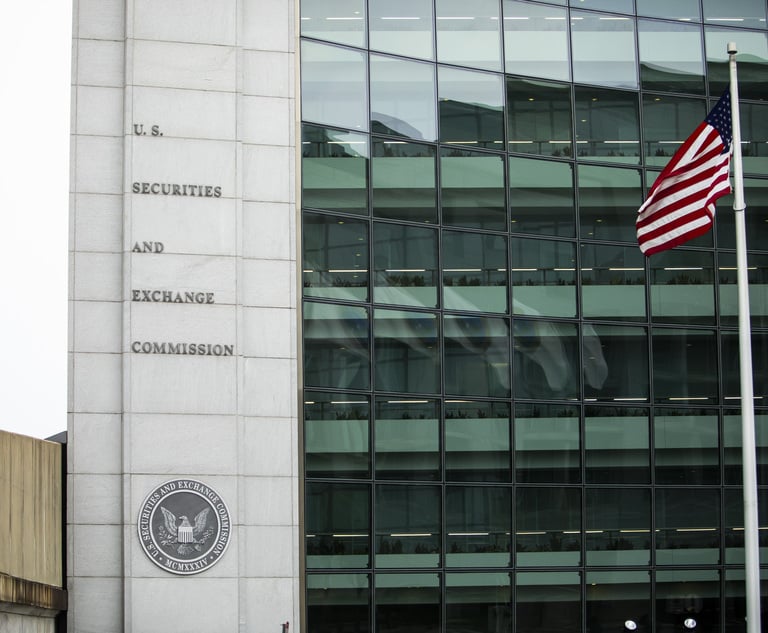Regulatory: Think twice before asserting a trade secrets claim
Asserting a claim under the Uniform Trade Secrets Act can backfire on the plaintiff and tip the balance of litigation leverage against the plaintiff and in defendants favor.
August 28, 2013 at 05:30 AM
4 minute read
The original version of this story was published on Law.com
A trade secrets claim can dramatically escalate the defendant's litigation exposure. The Uniform Trade Secrets Act provides a generous measure of damages, and if the defendant is found liable for willful misappropriation, then the exposure increases to include both fee shifting and multiple damages. Thus, it is not surprising that many plaintiffs consider a trade secrets claim an essential part of a strong offensive litigation strategy.
However, in-house and retained counsel should also consider carefully the risks of a trade secrets claim for a plaintiff. Asserting a claim under the Uniform Trade Secrets Act can backfire on the plaintiff and tip the balance of litigation leverage against the plaintiff and in the defendant's favor. The risk that a trade secrets defendant will use the claim to turn the tables on the plaintiff is often greatest when the plaintiff has pleaded the claim without adequate pre-suit investigation and analysis or has added the claim to the complaint as an afterthought simply to enhance the remedies that the plaintiff can include in its prayer for relief.
First, the plaintiff should consider the impact of a trade secrets claim on its own pleading and discovery burden. Conclusory allegations that provide only vague descriptions of the trade secrets may prompt defendant to file a motion to dismiss, drawing the plaintiff into motion practice that delays the case and adds expense. Once discovery commences, the defendant almost certainly will seek very broad and invasive discovery to test the plaintiff's right to trade secret protection. The defendant will explore through document discovery and depositions how the trade secrets were developed, how the plaintiff uses the trade secrets in its business, and how plaintiff protects the trade secrets from disclosure. Because trade secrets by their nature may be deeply embedded in the company's operations and strategic planning, it is often difficult for the plaintiff to define any clear limits to the scope of the discovery to which the defendant is entitled. This discovery may require voluminous document production and numerous depositions, and this burden will fall disproportionately on the plaintiff because the defendant has no comparable burden of pleading and proof.
Even apart from the burden, disruption and expense of this broad discovery, plaintiff's executives quickly may become alarmed by the risk to data security posed by invasive discovery. By definition, discovery in a trade secrets case requires placing copies of highly sensitive business records in the possession of opposing counsel on IT systems whose security measures may be unknown and over which the plaintiff has almost no control. Although a protective order may restrict certain categories of documents or information from disclosure to the defendant's executives or employees, most protective orders do not address at all the risk of inadvertent disclosure by opposing counsel or even hacking of opposing counsel's computers by a third party. The risk of disclosure only increases if the parties proceed to a hearing or trial, where counsel may confront a trial judge who is resistant to requests to seal extensive filings or to exclude the public from the courtroom.
As the parties progress to a decision on the merits of the trade secrets claim, the plaintiff will come face to face with the risk inherent in submitting for judicial determination the company's right to trade secret protection. A judicial determination that information is not entitled to trade secret protection can have significant impact on the company's ability to enforce confidentiality covenants in both its commercial and employment contracts and any related employee noncompetition covenants. Where the defendant has assembled credible evidence attacking the plaintiff's trade secrets, this risk can create significant settlement pressure.
Finally, the plaintiff should consider the risk that it too may be subject to fee shifting if its trade secret claim unravels in litigation, and the defendant develops evidence that the claim was brought in bad faith.
When a plaintiff asserts a trade secrets claim, it is escalating the risk for both sides of the suit. The plaintiff should consider carefully its own tolerance for these risks before making the decision to proceed with the claim.
This content has been archived. It is available through our partners, LexisNexis® and Bloomberg Law.
To view this content, please continue to their sites.
Not a Lexis Subscriber?
Subscribe Now
Not a Bloomberg Law Subscriber?
Subscribe Now
NOT FOR REPRINT
© 2025 ALM Global, LLC, All Rights Reserved. Request academic re-use from www.copyright.com. All other uses, submit a request to [email protected]. For more information visit Asset & Logo Licensing.
You Might Like
View All
Internal Whistleblowing Surged Globally in 2024, So Why Were US Numbers Flat?
6 minute read
FTC Finalizes Child Online Privacy Rule Updates, But Ferguson Eyes Further Changes
Trending Stories
- 1Bill Would Consolidate Antitrust Enforcement Under DOJ
- 2Cornell Tech Expands Law, Technology and Entrepreneurship Masters of Law Program to Part Time Format
- 3Divided Eighth Circuit Sides With GE's Timely Removal of Indemnification Action to Federal Court
- 4Former U.S. Dept. of Education Attorney Suspended for Failure to Complete CLE Credits
- 5ArentFox Schiff Adds Global Complex Litigation Partner in Los Angeles
Who Got The Work
J. Brugh Lower of Gibbons has entered an appearance for industrial equipment supplier Devco Corporation in a pending trademark infringement lawsuit. The suit, accusing the defendant of selling knock-off Graco products, was filed Dec. 18 in New Jersey District Court by Rivkin Radler on behalf of Graco Inc. and Graco Minnesota. The case, assigned to U.S. District Judge Zahid N. Quraishi, is 3:24-cv-11294, Graco Inc. et al v. Devco Corporation.
Who Got The Work
Rebecca Maller-Stein and Kent A. Yalowitz of Arnold & Porter Kaye Scholer have entered their appearances for Hanaco Venture Capital and its executives, Lior Prosor and David Frankel, in a pending securities lawsuit. The action, filed on Dec. 24 in New York Southern District Court by Zell, Aron & Co. on behalf of Goldeneye Advisors, accuses the defendants of negligently and fraudulently managing the plaintiff's $1 million investment. The case, assigned to U.S. District Judge Vernon S. Broderick, is 1:24-cv-09918, Goldeneye Advisors, LLC v. Hanaco Venture Capital, Ltd. et al.
Who Got The Work
Attorneys from A&O Shearman has stepped in as defense counsel for Toronto-Dominion Bank and other defendants in a pending securities class action. The suit, filed Dec. 11 in New York Southern District Court by Bleichmar Fonti & Auld, accuses the defendants of concealing the bank's 'pervasive' deficiencies in regards to its compliance with the Bank Secrecy Act and the quality of its anti-money laundering controls. The case, assigned to U.S. District Judge Arun Subramanian, is 1:24-cv-09445, Gonzalez v. The Toronto-Dominion Bank et al.
Who Got The Work
Crown Castle International, a Pennsylvania company providing shared communications infrastructure, has turned to Luke D. Wolf of Gordon Rees Scully Mansukhani to fend off a pending breach-of-contract lawsuit. The court action, filed Nov. 25 in Michigan Eastern District Court by Hooper Hathaway PC on behalf of The Town Residences LLC, accuses Crown Castle of failing to transfer approximately $30,000 in utility payments from T-Mobile in breach of a roof-top lease and assignment agreement. The case, assigned to U.S. District Judge Susan K. Declercq, is 2:24-cv-13131, The Town Residences LLC v. T-Mobile US, Inc. et al.
Who Got The Work
Wilfred P. Coronato and Daniel M. Schwartz of McCarter & English have stepped in as defense counsel to Electrolux Home Products Inc. in a pending product liability lawsuit. The court action, filed Nov. 26 in New York Eastern District Court by Poulos Lopiccolo PC and Nagel Rice LLP on behalf of David Stern, alleges that the defendant's refrigerators’ drawers and shelving repeatedly break and fall apart within months after purchase. The case, assigned to U.S. District Judge Joan M. Azrack, is 2:24-cv-08204, Stern v. Electrolux Home Products, Inc.
Featured Firms
Law Offices of Gary Martin Hays & Associates, P.C.
(470) 294-1674
Law Offices of Mark E. Salomone
(857) 444-6468
Smith & Hassler
(713) 739-1250








